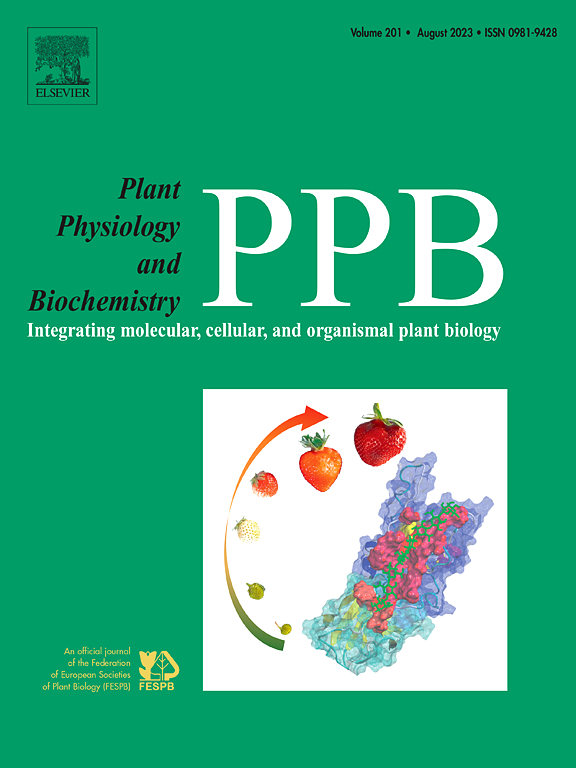CiBBX19 negatively regulates the flowering time of Chrysanthemum indicum by recruiting CiBBX5 to inhibit the expression of CiFTL3
IF 6.1
2区 生物学
Q1 PLANT SCIENCES
引用次数: 0
Abstract
Flowering is a critical stage in plant growth and reproduction. Chrysanthemum indicum, a species with both ornamental and medicinal value, has its flowering time directly affecting the quality of inflorescences. This study elucidates the molecular mechanism by which the BBX transcription factor family members CiBBX19 and CiBBX5 coordinately regulate the flowering time of Chrysanthemum indicum. Phylogenetic analysis reveals that CiBBX19 is the ortholog of AtBBX19, with its expression significantly downregulated during the vegetative-to-reproductive transition in leaves. Functional validation demonstrates that overexpression of CiBBX19 delays flowering, while its silencing accelerates this developmental transition, confirming its biological role in maintaining vegetative growth. Through qPCR time-course analysis and genetic transformation experiments, we identified the short-day responsive florigen gene CiFTL3 in Chrysanthemum indicum. The expression of CiFTL3 surges during the flower bud differentiation stage, and its overexpression advances the flowering time. The expression of CiFTL3 significantly decreases in CiBBX19-overexpressing lines, but yeast one-hybrid and LUC assays confirm that CiBBX19 does not directly bind to the CiFTL3 promoter. Protein interaction analysis reveals that CiBBX19 forms a heterodimer with CiBBX5. Although CiBBX5 exhibits stable expression during the developmental transition period, it specifically binds to the G-box cis-element (TACGTG) of the CiFTL3 promoter, thereby suppressing the expression of CiFTL3 and delaying the flowering in Chrysanthemum indicum. Through dual-luciferase reporter assays, we established that CiBBX19-CiBBX5 heterodimerization synergistically enhances transcriptional repression of CiFTL3, exceeding the inhibitory effect mediated by CiBBX5 alone. Our experiment showed that CiBBX19 can interact with CiBBX5 to indirectly inhibit the transcription of CiFTL3. This synergistic regulatory mechanism provides new insights into unraveling the dynamic balance between vegetative growth and reproductive development in Asteraceae plants and lays a molecular foundation for precise regulation of Chrysanthemum indicum flowering time.
CiBBX19通过募集CiBBX5抑制CiFTL3的表达,负向调控菊花开花时间
开花是植物生长繁殖的关键阶段。菊花是一种具有观赏和药用价值的植物,其开花时间直接影响花序质量。本研究阐明了BBX转录因子家族成员CiBBX19和CiBBX5协同调控菊花开花时间的分子机制。系统发育分析表明,CiBBX19是AtBBX19的同源基因,在叶片从营养向生殖转变的过程中,CiBBX19的表达显著下调。功能验证表明,过表达CiBBX19会延迟开花,而其沉默则会加速这一发育转变,从而证实了其在维持营养生长中的生物学作用。通过qPCR时程分析和遗传转化实验,鉴定了菊花短日反应致花基因CiFTL3。CiFTL3在花芽分化阶段表达激增,其过表达提前开花时间。CiFTL3的表达在CiBBX19过表达系中显著降低,但酵母单杂交和LUC实验证实CiBBX19不直接结合CiFTL3启动子。蛋白相互作用分析表明,CiBBX19与CiBBX5形成异源二聚体。虽然CiBBX5在发育过渡期表现稳定表达,但它特异性结合CiFTL3启动子的G-box顺式元件(TACGTG),从而抑制CiFTL3的表达,延缓菊花开花。通过双荧光素酶报告基因检测,我们发现CiBBX19-CiBBX5异源二聚化协同增强了CiFTL3的转录抑制,超过了CiBBX5单独介导的抑制作用。我们的实验表明,CiBBX19可以与CiBBX5相互作用,间接抑制CiFTL3的转录。这一协同调控机制为揭示菊科植物营养生长与生殖发育的动态平衡提供了新的思路,并为菊花开花时间的精确调控奠定了分子基础。
本文章由计算机程序翻译,如有差异,请以英文原文为准。
求助全文
约1分钟内获得全文
求助全文
来源期刊
CiteScore
11.10
自引率
3.10%
发文量
410
审稿时长
33 days
期刊介绍:
Plant Physiology and Biochemistry publishes original theoretical, experimental and technical contributions in the various fields of plant physiology (biochemistry, physiology, structure, genetics, plant-microbe interactions, etc.) at diverse levels of integration (molecular, subcellular, cellular, organ, whole plant, environmental). Opinions expressed in the journal are the sole responsibility of the authors and publication does not imply the editors'' agreement.
Manuscripts describing molecular-genetic and/or gene expression data that are not integrated with biochemical analysis and/or actual measurements of plant physiological processes are not suitable for PPB. Also "Omics" studies (transcriptomics, proteomics, metabolomics, etc.) reporting descriptive analysis without an element of functional validation assays, will not be considered. Similarly, applied agronomic or phytochemical studies that generate no new, fundamental insights in plant physiological and/or biochemical processes are not suitable for publication in PPB.
Plant Physiology and Biochemistry publishes several types of articles: Reviews, Papers and Short Papers. Articles for Reviews are either invited by the editor or proposed by the authors for the editor''s prior agreement. Reviews should not exceed 40 typewritten pages and Short Papers no more than approximately 8 typewritten pages. The fundamental character of Plant Physiology and Biochemistry remains that of a journal for original results.

 求助内容:
求助内容: 应助结果提醒方式:
应助结果提醒方式:


